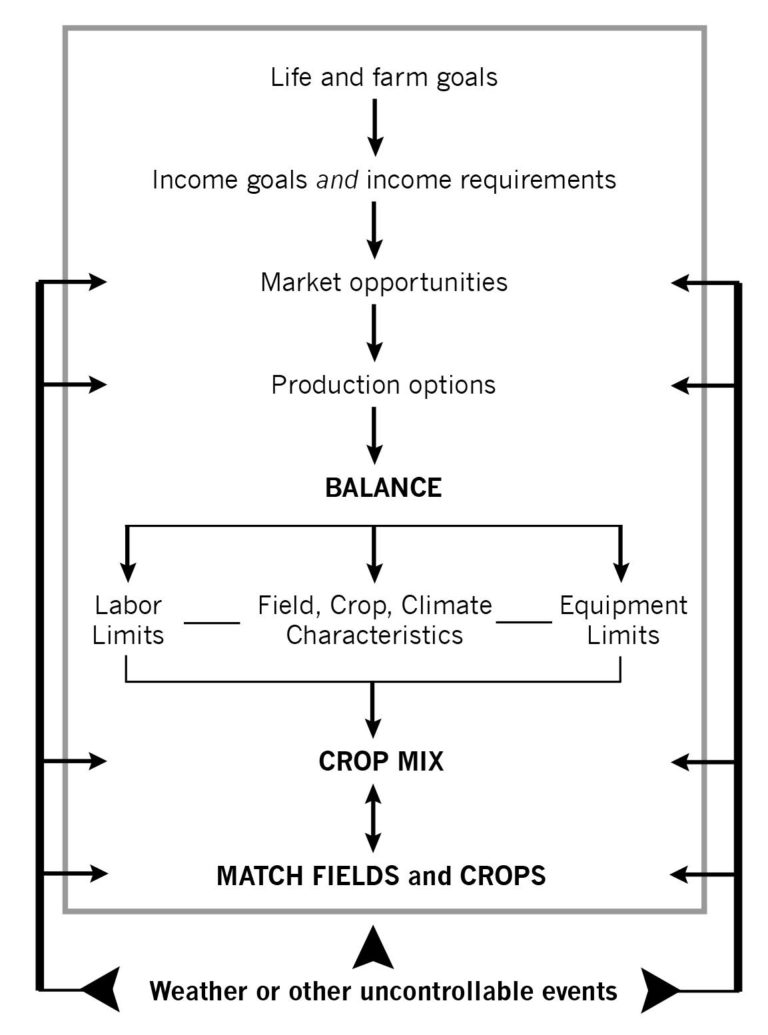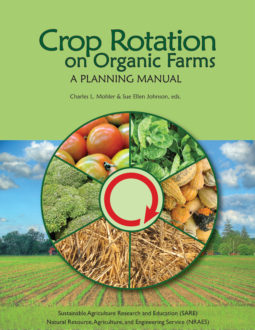
Our panel of expert organic farmers participated in a structured, facilitated process that was designed to elicit an outline of step-by-step decisions and actions related to their own management of crop rotation (sidebar 2.6). This is summarized in the chart “Managing a Crop Rotation System." The content and wording of the chart are those of the expert farmers. The chart reflects both their common practices and how they think about those practices.
The primary purpose of the chart is to provide insight into the decisions and actions followed by experienced organic growers as they manage crop rotations. The responsibilities and tasks outlined in the chart demonstrate how expert farmers integrate crop rotation decisions into the overall planning and operation of their farms. The chart provides a general, overall guide to all of the steps needed to manage crop rotations on an organic farm. Chapter 5 presents tools based on the experts’ recommendations that will help in executing several priority tasks on the chart.
How to Read the Chart
The left hand column of the “Managing a Crop Rotation System” chart represents eight broad “key responsibilities” necessary for managing crop rotations. Each key responsibility is associated with a set of necessary “tasks” described in the boxes that run across the page. These tasks must be completed to fulfill the responsibility. (Note that the tasks associated with a key responsibility sometimes take up more than one row.)
Bear in mind the following when consulting the chart:
- The word crop refers to both cash and cover crops unless otherwise specified.
- The responsibilities are listed more or less in the order in which they are performed. Managing a crop rotation, however, is neither a linear nor a cyclical process. Although the chart is organized in a quasi- chronological order, farmers’ decisions and actions move back and forth among many of the tasks and responsibilities listed. This back-and-forth process is schematically presented in figure 2.3.
- Many expert farmers do extensive planning and record keeping on paper. Most have some form of field maps. Some use computers. A few keep all details in their heads. Most of the panel farmers agreed that farmers should write down their field records and plans.
- Many of the key responsibilities and tasks require reflection and observation as well as information. Expert farmers agree that frequent, careful field observations are critical.
- The chart illustrates the central role of rotation in the overall farming operation. The chart does not cover all aspects of farm management—only those that the farmers thought were most important in determining the rotation and that are linked to rotation management. Some tasks and key responsibilities relate to the entire farm and others to the rotation on a particular field. Some tasks are mental “desk tasks” (for example, B-13, “Review regulations”), and some are physical (F-10, “Plant crops”). Some relate to information processing (G-6, “Assess disease control”); others center on decision making (E-7, “Determine crop quantities”).
Sidebar 2.6
The NEON Expert Farmer Rotation Workshop
The New England Small Farm Institute adapted a process called Develop a Curriculum, or DACUM (78a), to understand and present the decision process followed by expert farmers in planning and implementing organic vegetable rotations. The DACUM process was first created at Ohio State University to develop training materials based on the knowledge of experienced workers in business and industry. It was built around the idea that skilled individuals currently performing a job are better able than anyone else to describe the job and how they do it. The approach provided a structured forum for farmers to successfully communicate about management of their farms. The expert farmers created the chart “Managing a Crop Rotation System,” which details the key responsibilities for management of successful rotations and the tasks associated with each responsibility. It gave scientists a unique perspective on how farmers manage their systems and how research is used by farmers.
The Expert Growers
Twelve expert organic vegetable growers (figure 2.2) who farm from Maryland to Maine were nominated by sixteen organic farming organizations and organic certifiers in the northeastern US to participate in the three-day NEON Expert Farmer Rotation Workshop in 2002. Each of them had been farming for eight or more years, and vegetables are the primary crops on all twelve farms. Their operations range in size from 5 acres to 200 acres. They employ an array of marketing strategies, from wholesale to community-supported agriculture (CSA). Twenty other growers with similar qualifications reviewed the chart and other materials produced by the workshop (e.g. lists in sidebars 2.7, 2.8, 2.9, and 2.12). Together, the expert farmers and the reviewers are representative of the best farms in the northeast US. (Farmer profiles are presented in sidebar 4.2).
Every responsibility listed on the chart needs consideration each year. They do not necessarily have to be addressed in the order listed, but responsibilities A through E primarily occur during the relatively quiet winter months, when production and marketing pressures are less intense and time is available to take stock and look to the growing seasons ahead; responsibility F (the actual execution and implementation of the rotation) begins in early spring and continues throughout the growing season; and responsibilities G and H intensify in fall and winter, following the most hectic portions of the field season.
Some tasks require great attention every year, while others require little effort unless the farm is undergoing major changes. Some tasks are executed only once each season (C-3, “Test soils”); some are repeatedly revisited (F-8, “Prepare work schedule”), and some carry over from one year to the next (C-9, “Categorize crops”).
